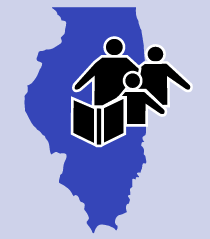
Speech and Language Are EI’s Most Common Delays
Many families seek early intervention for concerns about their child’s speech. Delays in language is the most common type of developmental delay. A child’s first three years is the most intensive period for acquiring speech and language skills. These skills develop best in an environment filled with a variety of sights, sounds and consistent exposure to the speech and language of others.
An infant’s brain actually responds best to a type of speech known as “parentese,” which adults naturally use when talking to babies. This type of speaking uses short, simple sentences, prolonged vowel sounds, more inflection in the voice, and a higher pitch than speech used to talk to other adults. The development of language is tremendously influenced by parent-child interactions. It is important to talk, sing, and read to a baby often so the child can learn the sounds of his/her native language.
Hearing two languages spoken at home is a real advantage to a child. If a baby hears two languages from birth, he or she will maintain the ability to hear the sounds of both and be able to speak each language with the accent of a native speaker. It is helpful if the child hears the same language from someone who is a native speaker. The child may mix the languages initially in their own speech, but it will typically get sorted out by age 3.
Delays in speech and language can stem from a variety of reasons. Although the two are frequently referred to together, there are some differences between speech and language delay. Speech is the physical act of producing sounds and saying words. A toddler with a speech delay may try but have trouble forming the correct sounds to make words. A language delay involves understanding and communicating, both verbally and nonverbally.
A toddler with a language delay might be late to start using words or gestures (e.g., pointing, waving bye-bye). They may not respond to their names or basic, routine directions (e.g., get your shoes). Children can have a speech delay or a language delay, and the two conditions can sometimes overlap. For example, a child may have oral-motor problems (difficulty controlling speech muscles) and repeated ear infections resulting in a delay in speech and expressive language.
The Role of a Speech Pathologist in Early Intervention
By Tracy Gunderson
Many families in early intervention have a speech pathologist (SLP) on their EI team. A speech pathologist (SLP) with early intervention (EI) credentials has unique knowledge and skills.
A speech pathologist has a master’s degree in speech pathology, is credentialed through early intervention, and completes ongoing continuing education pertaining to early intervention. The SLP collaborates with families and other team members to address the child’s communication and feeding development.
A speech pathologist is part of the EI evaluation team and assesses the child’s speech, oral motor skills, understanding of spoken language, expressive communication, and social interaction. In addition, the SLP may evaluate the child’s feeding skills.
Many people wonder how speech therapy can apply to a child in their first years of life. The SLP works closely with the family to identify routines in which communication can be addressed. Incorporating language into dressing, mealtime, bathtime, play, and other routines provides the family multiple opportunities each day to develop a child’s communication skills.
Speech sounds, words, and expressive language can very easily be incorporated into play activities such as snack time, building with blocks, rhymes and fingerplays, and “people games” such as chase and peekaboo.
If a child is exhibiting difficulties with speech sound development and words, communication can be enhanced using sign language or communication apps or devices, which can provide pictures to let a child point to a choice.
Getting started early with sign language or picture communication can be very beneficial for the young child and can help to decrease frustration for both the child and the family. All of the ways we share our ideas and feelings without talking are referred to as augmentative or alternative communication (AAC), such as using signs for common words like up, more, drink, done, and potty.
Some children may need support in developing engagement, turn taking, and joint attention. The SLP collaborates with the family and other team members to identify play activities to promote the child’s attention, interest, and engagement with people. The SLP observes the parents’ play with their child and provides strategies to help promote the child’s initiation, turn taking, and requests for more action.
If a child has difficulty with feeding, the SLP can identify and provide strategies to improve feeding. A child may have difficulty swallowing and may be referred for a swallow study at a local hospital or clinic.
A swallow study can provide an important piece of information about the feeding process. The SLP and family collaborate on ways to help the child develop confidence and comfort in the development of feeding skills.
The speech pathologist works closely with other team members including the family, developmental therapist, occupational therapist, and physical therapist to help promote a child’s feeding and communication development.
State Systemic Improvement Plan (SSIP) Update
Our report to the Office of Special Education Programs was submitted on April 1. We shared information about our efforts to improve family engagement through professional development and local support. We also briefly described the impact of the pandemic on this work. Our next step is to bring stakeholders together to discuss our progress and plans for expanding these efforts beyond our three pilot areas. In the meantime, leadership teams continue to be an integral support for providers’ use of coaching and engagement practices as we shift back to in-person services.
Get Out and Enjoy the Outdoors
Like many of us, you are probably excited for summer. In previous summers, you may have looked forward to playing in the park, visiting museums, and exploring nearby areas. With COVID-19, you may be wondering: What can I safely do with my children this summer?
Here we suggest summer activities for your family to help you safely enjoy the nice weather. Every family copes with COVID-19 precautions differently, and that is okay! The purpose of this list is for you to find activities that work best for you.
Because young children still can’t be vaccinated, always wear a mask when appropriate and try to social distance as much as possible. Here are some suggested ideas for safe, summer fun.
- Go to a local or state park
- Have summer picnics in the park or back yard
- Have an outdoor, small playdate with social distancing activities such as bubble play or drawing with sidewalk chalk
- Have fun with shaving cream and sand sensory play
- Run through the sprinkler together or take a walk in the rain
- Visit outdoor attractions
Finally, check for COVID rates in your area or areas you plan to visit to make informed decisions and safely enjoy time spent with your family.
Early Intervention Reopening Update
As of June 2021, there is updated guidance from the Bureau of Early Intervention. The changes include:
- The EI team (i.e., the family and the EI providers) should discuss service delivery options and potential risk factors to determine how EI services will be delivered.
- It is recommended that fully vaccinated EI providers support families requesting in-person services.
- There are no longer any limits on the number of families that can be seen in-person by an EI provider.
- If the family agrees, there can be more than one EI provider in the home during in-person visits.
- The family and EI providers should continue to wear masks during indoor in-person visits. When possible, in-person visits should be conducted outdoors or in well-ventilated areas. If the visit is outdoors and distancing can be accomplished, masks can be removed (if the family agrees).
- Team members should continue to wash hands and sanitize items.
- In-person visits should not occur if:
- any individual has tested positive for COVID-19 in the last 14 days, OR
- any individual is experiencing COVID-19 symptoms, OR
- an individual who is not fully vaccinated has been exposed to COVID-19 in the last 14 days.
- In the event of COVID-19 exposure, EI providers and families need to adhere to the local health department’s quarantine guidelines. Such guidelines may override this guidance.
While in-person services may be more available, live video visits will continue to be available to families.

